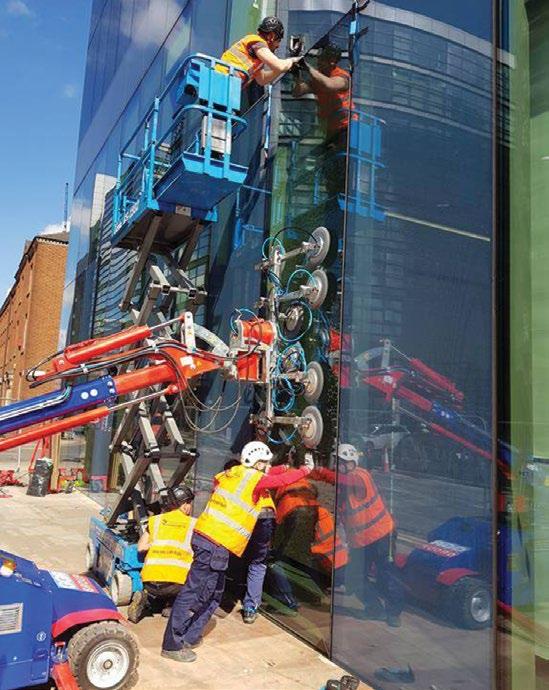
3 minute read
Heavy glass
Heavy glass
There was a time when windows and glass panels were invariably installed by hand, a big window would simply require more people to help carry and lift it into place. Over the past 20 years it has changed beyond all recognition, and has mostly been driven by two major factors. Firstly, stringent manual handling rules, which are increasingly applied throughout Europe, now require every employer to risk assess manual lifting, essentially limiting how much a person can lift to 40kg – or 25kg if the lifting task is repetitive or routine.
At the same time glass panels in both commercial and residential buildings have become significantly heavier, thanks to increased insulation requirements. This is likely to further increase as triple glazing is more widely used.

The lifting industry has responded positively with numerous manufacturers now offering a vast array of glass handling robots, along with vacuum lifting equipment for use with cranes and telehandlers. Commercial contractors have largely adopted mechanised forms of glass handling on all of their projects, however, smaller builders still tend to rely on manual ‘grunt’ to install even relatively large or heavy windows. The fact is with the right equipment the work is not only safer and easier but also substantially faster and more accurate.
Rental companies all over Europe have also responded well, tuning into the opportunities this equipment offers. While many general rental companies now stock these products, an increasing number of specialist rental companies are now getting involved. After all, glass handling equipment fits well with the lifting equipment offered by crane, telehandler and aerial lift rental companies.
Manufacturers such as Jekko and the European spider crane distributors such as Kranlyft, which handles Maeda throughout Europe, also offer glass handling attachments and robots. Kranlyft has taken on the German built Uplifter Glassworker line. Unic’s European distributor GGR, came from the other direction, having started in the glass handling field it added spider and mini crawler cranes later. As one of Europe’s leading glass handling specialists, the next two pages cover a slew of new products that the company launched at a recent open day.

More glass handling
With interest in this subject growing, we plan to cover the subject of glass handling more often in future issues and would be happy to hear from those of you working in the industry. The following are few items of news and applications.
Counter balance beam in action
When it came to installing six by 2.8 metre prefabricated wood façade panels - complete with window frames and glazing - seven storeys up, manufacturer Anton Ambros and contractor Heavydrive decided to use counter balance/overhang beam fitted with 400mm forks. The beam was connected to the project’s tower crane with the installation team using radio remote controls to operate the crane.

The Beast
In July, German glass handling equipment manufacturer Uplifter launched its largest pedestrian controlled glazing robot to date with the 1,125kg Glassworker GW 1125. Dubbed ‘the Beast’, it can handle its full capacity at a radius of 320mm and take it to a height of 2.4 metres. With its short front hydraulic stabilisers deployed it can handle 330kg at its maximum outreach of 2.32 metres and at its maximum height of 4.55 metres. One of its first jobs involved the installation of six metre by 2.1 metre glazing panels weighing more than 900kg.

Curve ball
When a new pharmacy in Stuttgart’s city centre ordered special curved glass panels for its façade, the contractor sensibly factored in a breakage factor, based on previous experience. He contacted glazing company Lanz from Rutesheim to deliver and place the hand crafted panels. Lanz used its 85 tonne/metre truck mounted Palfinger LK 370 equipped with a 600kg Kappel 16 suction cup vacuum lifter. The glass panels had to be lifted, rotated, and placed, the job was completed with zero breakages.












